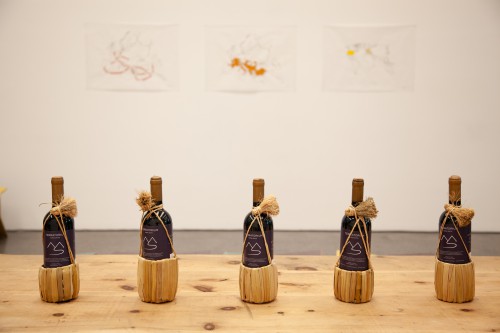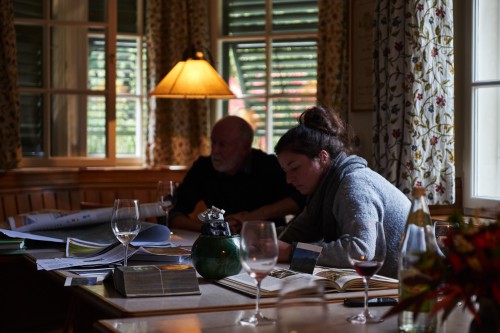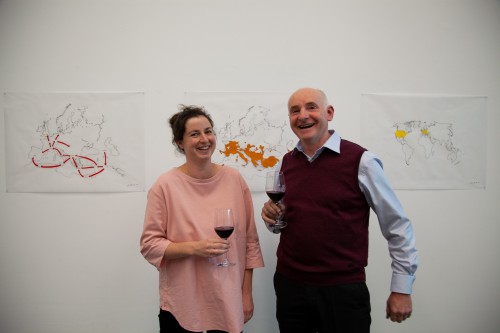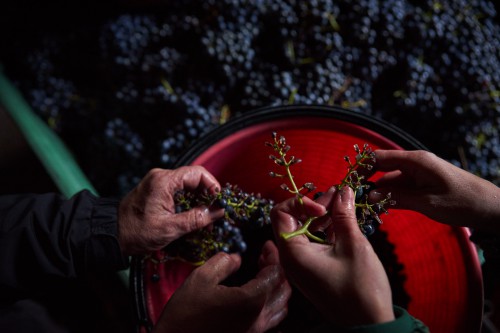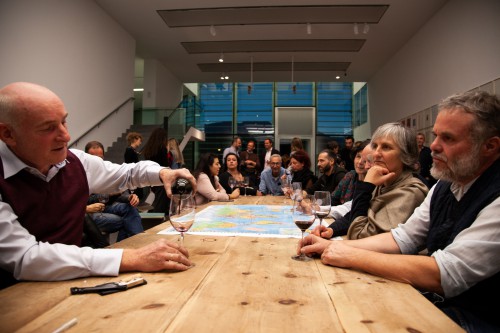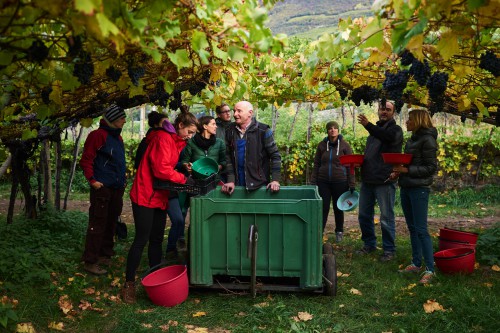TERRATORIUM
realisiert in Zusammenarbeit mit Erbhof Mayr-Unterganzner
kuratiert von BAU
Präsentation und Verkostung der Kunstedition
19.06.2019
19 Uhr
Delfina Foundation, London
im Rahmen von The Politics of Food
13.10.2018
18:00 Uhr
MUSEION
P.Siena Platz 1
39100 Bozen
Im Rahmen des 14. Tages der Zeitgenössischen Kunst stellen die Künstlerin Emma Smith und der Weinproduzent Josephus Mayr den Wein Terratorium vor und nehmen uns während der Verkostung mit auf eine Reise zu den Ursprungsorten der Geschmacksnoten, mit denen uns der Werdegang dieses Weines verbindet.
Terratorium wurde 2016 aus lokaler Lagrein-Traube am Erbhof Mayer-Unterganzner in Kardaun bei Bozen in Südtirol hergestellt, von Hand geerntet und entrappt und in einem speziell aus lokaler Eiche hergestelltem Fass zur Reifung gelagert. Nach der zweijährigen Lagerung wurde Terratorium nun in traditionell hergestellte ‘fiaschi’ aus Montelupo Fiorentino abgefüllt und wird als limitierte Kunstedition erstmals einem Publikum präsentiert.
Nach der Verkostung gibt es die Möglichkeit Terratorium zu
120 Euro pro Kunstedition zu bestellen.
Terratorium ist seit 2019 ausverkauft.
22. Oktober 2016 8 – 14 Uhr Workshop
23. November 2016, 19 Uhr Eröffnung Terratorium
Ort: Erbhof Mayr-Unterganzner
Die international erfolgreiche britische Künstlerin Emma Smith (*1981) erkundet in ihrem Kunstprojekt Terratorium den Ursprung und die Vernetzung eines ortspezifischen Geschmackes. Kann ein Geschmack ortsspezifisch sein? In Zusammenarbeit mit dem Erbhof Mayr-Unterganzner in Kardaun bei Bozen, produzierte Smith ein Barrique Lagrein, wobei der Herstellungsprozess so ortsverbunden wie möglich gehalten wird. Die auf der selbstgezogenen Rebe des Unterganznerhofes gereiften Trauben wurden im Oktober 2016 geerntet und manuell entrappt. Seitdem lagern sie zur Spontangärung im eigens hergestellten Fass. Das Holz stammt von einer Eiche, die in unmittelbarer Nähe gewachsen ist.
Mit Anwesenheit der Künstlerin Emma Smith fand am 22. Oktober 2016 die Ernte und die manuelle Entrappung der Trauben statt. Gleichzeitig wird dieser Arbeitsprozess als Recherchemoment genutzt, wo gemeinsam über die Frage „Wie ist der Ort an dem wir jetzt sind nach außen verbunden?“ reflektiert wird. Eingeladene Experten waren der Weinbauer Josephus Mayr, Weinakademiker Christoph Tscholl, Geologe Konrad Messner, Meteorologe Manuel Oberhuber und Förster Laurin Felix Mayer.
Am 23. November um 19 Uhr fand die erste performative Verkostung des Jungweines und Präsentation von Terratorium am Erbhof Mayr-Unterganzner statt.
Bei der Weinproduktion wird der Geschmack eines Terroirs aus der Erde extrahiert. Smiths Absicht ist es diesen Vorgang zu intensivieren indem so weit wie möglich ortsfremde Materialien ausgeschlossen bleiben. Es soll die Herkunft zum Vorschein bringen und sozusagen die Essenz des Ortes destillieren. Mit dem Kunstprojekt Terratorium untersucht Smith wie trotz des Ursprunges an einem Ort jedes Element im Prozess der Entstehung letztlich in Verbindung zu anderen Orten steht bzw. in Bewegung ist: der Ort ist geographisch lokalisierbar und gleichzeitig mit anderen Erdpunkten verbunden.
Anlässlich der Ernte und manuellen Entrappung setzte sich die Künstlerin am Erbhof Mayr-Unterganzner mit einem Geologen, Meteorologen, Förster und Weinakademiker zusammen um der Frage nachzugehen “Wie ist der Ort an dem wir jetzt sind nach außen verbunden?”. Bunte geologische Karten zeigen eine Vielfalt an Gesteinen in Südtirol auf, deren Entstehungsort oft hunderte von Kilometern entfernt auf der afrikanischen oder europäischen Platte liegt. Die geologische Vielfalt drückt sich in unterschiedlichen Aromen aus. Die sprachlichen Ausdrücke dafür bedienen sich nicht nur lokaler Geschmacks-und Geruchswahrnehmungen sondern greifen auf weitreichende, weltweite sinnliche Erfahrungen zurück mit Begriffen wie Vanille, Zitrone, Himbeere und Zimt. Smith gab bei der Weinverkostung am 23. November einen visuellen und performativen Einblick in die Verwobenheit eines Geruches und Geschmackes.
Jetzt reift der Wein Terratorium für zwei Jahre im speziell hergestellten Eichenfass, um im Herbst 2018 in eigens dafür entworfenen Flaschen abgefüllt und als limitierte Künstleredition verkauft zu werden.
Unterstützt von: Autonome Provinz Bozen Südtirol, Deutsche Kultur, Stiftung Südtiroler Sparkasse, Autonome Region Trentino-Südtirol
TERRATORIUM
realised in collaboration with Family Estate Mayr-Unterganzner
curated by BAU
Presentation and tasting of the art edition
19.06.2019
7pm
Delfina Foundation, London
in the framework of The Politics of Food
13.10.2018
6pm
MUSEION
P. Siena Piazza 1
39100 Bolzano
In the context of the fourteenth Day of Contemporary Art in Italy, artist Emma Smith and winemaker Josephus Mayr-Unterganzner present the wine Terratorium. During the tasting they take us on a journey back to the origins of the flavours, connecting us to them through the experience of the wine.
Terratorium is made using the local lagrein variety, harvested and processed by hand and matured in local oak at the Mayr-Unterganzner family estate in Cardano, Bolzano, South Tyrol. Terratorium is matured for two years and bottled using the traditional practice of the ‘fiaschi’ from Montelupo Fiorentino in Tuscany; it will be presented to the public as a limited edition artwork.
After the tasting visitors will have the opportunity to order Terratorium at the price of 120 euros per edition.
Terratorium is sold out since 2019.
22 October 2016 8am – 2pm Workshop
23rd November 2016 7pm Opening Terratorium
Venue: Family Estate Mayr-Unterganzner
In her project Terratorium the artist Emma Smith (*1981) explores the origin and the interconnectedness of a site-specific taste. Can a taste be site-specific? In collaboration with the Family Estate Mayr-Unterganzner in Cardano close to Bolzano, Smith produces a barrique barrel of Lagrein, by keeping the production process as local as possible. Home-grown on a vine raised at the Unterganznerhof vineyard, the grapes were harvested in October and manually destemmed. The custom-built barrel in which they were then stored to achieve a process of spontaneous fermentation is made from the wood of an oak tree grown nearby.
On November 23rd 7pm BAU, Emma Smith and the family Mayr invited for a performative tasting of the first wine and presentation of Terratorium at the Family Estate Mayr-Unterganzner.
Wine making extracts the taste of its terrain. As a process of distilling the essence of a place, it could be argued to be more authentic than any other form of origination – the vine grows from the earth of its origin in which its roots are literally dug deep. With the project Terratorium the artist explores how even in this most direct origination each element in the process of the wine’s coming into being is ultimately connected to elsewhere and on a journey: place is both locally specific and universal at the same time.
On the occasion of the harvest and manual destemming process , on the 22nd October the artist met with a geologist, a meteorologist, a forest warden and a wine expert at the Mayr-Unterganzner family estate to explore the question “How does where we are connect to elsewhere?”. Invited experts were the vine farmer Josephus Mayr, sommelier Christoph Tscholl, geologist Konrad Messner, meteorologist Manuel Oberhuber and forester Laurin Felix Mayer.
In a multitude of colours, geological maps illustrate the vast variety of rock types present in South Tyrol, some of which originated hundreds of kilometres away on the African and European plate. This geological diversity is reflected in a number of different aroma hues which, when translated into words, are often likened not only to local scents and flavours but also to a more ample, sensual range of experiences from across the globe: vanilla, lemon, raspberry or cinnamon, for instance. In a singular tasting session on 23rd November, Emma Smith offered a visual and performative glimpse of how intrinsically interwoven flavours and scents are.
The wine Terratorium is now left to mature in its specially-manufactured oak barrel for two years, after which it will be bottled in tailor-made design containers in fall 2018 and distributed as an artist’s edition.
Supported by: Provincia Autonoma di Bolzano Alto Adige, Fondazione Cassa di Risparmio, Regione Autonoma Trentino-Alto Adige
TERRATORIUM
realizzato in collaborazione con il maso Mayr-Unterganzner
a cura di BAU
Presentazione e degustazione dell’edizione d’artista
19.06.2019
7pm
Delfina Foundation, London
nel contesto di The Politics of Food
13.10.2018
ore 18:00
MUSEION
P. Siena Piazza 1
39100 Bolzano
Nel contesto della Quattordicesima Edizione della Giornata del Contemporaneo l’artista Emma Smith e il produttore di vini Josephus Mayr presenteranno il vino Terratorium e durante la degustazione ci accompagneranno a percorrere un viaggio ai luoghi d’origini dei gusti di questo vino.
Terratorium è stato realizzato con una varietà locale di Lagrein, vendemmiato, lavorato a mano e maturato in botti di rovere locale al maso Mayr-Unterganzner di Cardano, Bolzano, Alto Adige. Dopo la maturazione di due anni, Terratorium è stato imbottigliato ricorrendo all’uso tradizionale dei ‘fiaschi’ di Montelupo Fiorentino in Toscana e in questa occasione l’edizione d’arte limitata sarà presentata per la prima volta al pubblico.
Dopo la degustazione sarà possibile ordinare Terratorium à 120 Euro per edizione d’arte.
Terratorium è esaurito dal 2019.
22 ottobre 2016 0re 8 – 14 Workshop
23 novembre 2016 ore 19 Inaugurazione Terratorium
Località: il maso Mayr-Unterganzner
Con il progetto artistico Terratorium, l’artista britannica di successo internazionale Emma Smith (* 1981) esplora l’origine e la messa in rete di un gusto endemico. Fino a che punto può arrivare il carattere endemico di un gusto? è la domanda che accompagna il progetto. In collaborazione con il maso Mayr-Unterganzner di Cardano (Bolzano), Smith produce un barrique di Lagrein. La produzione del vino rispetta il più possibile il legame con il luogo. Le viti, cresciute e coltivate al maso Unterganzner, sono state vendemmiate ad ottobre e diraspate manualmente. Da allora, l’uva stagiona seguendo una fermentazione spontanea in un barile costruito ad hoc con il legno di una quercia cresciuta nelle vicinanze del maso.
Il 23 novembre 2016 alle ore 19 BAU, Emma Smith e la famiglia Mayr invitano a una degustazione performativa del vino nuovo e presentazione di Terratorium presso il maso Mayr-Unterganzner.
Durante la produzione del vino, avviene l’estrazione del gusto di un Terroir dal terreno. Smith intende intensificare questo processo escludendo il più possibile quegli elementi estranei al luogo. Si tratta di un processo volto a distillare dell’essenza di un luogo per rendere autentica la provenienza del vino. La vite cresce nel e dal terreno, il vino proviene da un terreno nel quale è radicato nel vero senso della parola. Con Terratorium l’artista indaga come ogni elemento coinvolto nel processo mantiene pur sempre un legame con altri luoghi. Ogni elemento, seppur locale, contiene in sé un movimento: il luogo rimane così geograficamente collocabile e allo stesso tempo universale.
In occasione della vendemmia e della diraspatura manuale il 22 Ottobre 2016 l’artista incontra al maso Mayr-Unterganzner un geologo, un meterologo, una guardia forestale e un enologo per approfondire e sviluppare la domanda “come si lega il luogo nel quale siamo in questo momento con l’altrove?”. Dalle mappe colorate emerse dall’incontro si possono scoprire una varietà di pietre presenti in Alto Adige, la cui provenienza spesso si trova a centinaia di chilometri sulla placca africana ed europea. Gli esperti invitati sono il viticoltore Josephus Mayr, l’enologo Christoph Tscholl, il geologo Konrad Messner, il meteorologo Manuel Oberhuber e la guardia forestale Laurin Felix Mayer.
Questa varietà geologica si esprime anche nei vari aromi. A livello linguistico, le espressioni usate per descrivere un gusto e un sapore non si servono solo dell’esperienza locale ma riflettono una dimensione universale dell’esperienza sensoriale. Nelle descrizioni dei vini, compaiono spesso parole come vaniglia, limone, lampone o cannella, che portano con sé costellazioni spaziali inaspettate. Durante la degustazione del 23 novembre, Smith ha condiviso una riflessione in chiave visiva e performativa sull’intreccio irriducibile di gusto e sapore.
Adesso il vino Terratorium è stoccato per due anni nel barile di quercia prodotto ad hoc, per poi essere imbottigliato nell’ autunno 2018 in bottiglie disegnate per l’occasione. Il vino sarà poi venduto come edizione limitata d’artista.
Grazie al supporto di: Provincia Autonoma di Bolzano, Fondazione Cassa di Risparmio, Regione Trentino-Alto Adige



